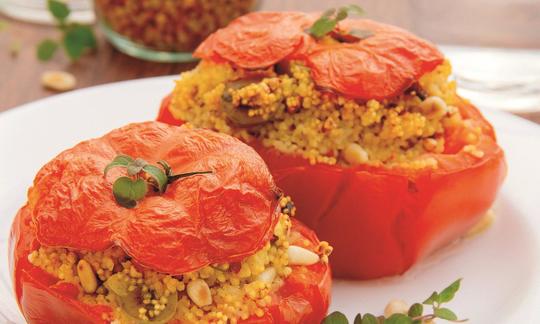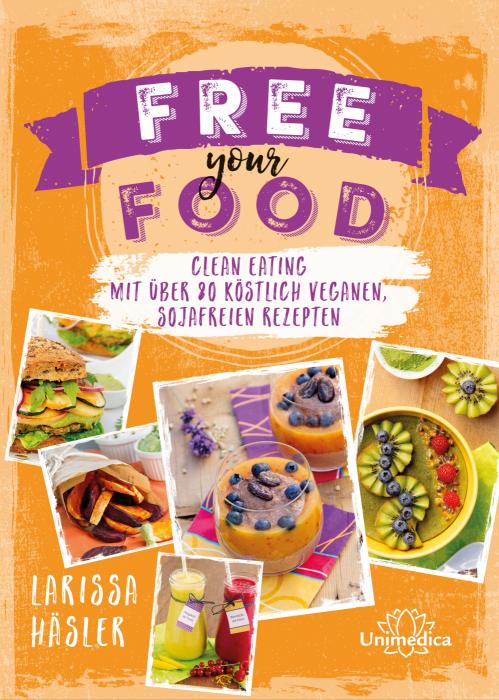Stuffed Tomatoes with Millet, Sun-Dried Tomatoes, and Olives
vegan
Ingredients (for servings, )
| For the filling | |
|---|---|
| 2 cloves | Garlic (organic?) (0.21 oz) |
| 5 ½ oz | Millet, raw (golden millet, panicle millet, millet, organic?) |
| 350 ml | Vegetable broth with little salt (organic?) (12 oz) |
| ½ tsp | Chili flakes (raw?, organic?) (0.08 oz) |
| 2 ⅛ oz | Tomatoes, dried (raw?, organic?) |
| 2 ¾ oz | Olives, green, pitted, raw (organic?) |
| 2 tbsp | Pine nuts, raw (seeds, organic?) (0.48 oz) |
| 4 sprigs | Greek oregano, raw (organic?) (0.37 oz) |
| For the tomatoes | |
| 4 | Beef tomatoes, raw (organic?) (35 oz) |
| Optional: for the buckwheat crunch | |
| 1 ¾ oz | Buckwheat, raw (organic?) |
| ¼ tsp | Paprika powder, hot (raw?, organic?) (0.02 oz) |
| Seasoning and serving | |
| 1 dash | Table salt (table salt, raw?, organic?) (0.01 oz) |
| 1 dash | Black pepper (organic?, raw?) (0.00 oz) |
Equipment
- skillet (frying pan)
- stove
- saucepan
- oven
Type of preparation
- cook
- bake
- chop or grind
- dry roast
- season to taste
- remove the skin
Preparation
For the filling
Peel and mince the garlic. Add the millet, garlic, chili flakes, and reduced-sodium vegetable broth to a saucepan and bring the mixture to a boil. Allow to boil for about 10 minutes. Then reduce the heat and let simmer for about 15 to 20 minutes.The author uses quick-cooking millet which cooks in about 10 to 15 minutes. If you use regular millet as called for above, it will take longer to cook. We use reduced-sodium vegetable broth to decrease the amount of salt as compared to the original recipe.
While you are waiting for the millet to cook, finely chop the sun-dried tomatoes and olives. Toast the pine nuts in a dry skillet until golden brown. Remove the oregano leaves from the stem and coarsely chop.
Other types of oregano also work well in this recipe. We have purposely chosen the most aromatic type that will retain its flavor when cooked.
For the tomatoes
Wash the tomatoes and then cut the tops off. Use a knife or a spoon to carefully scoop out the seeds and some of the pulp, leaving a hollowed-out shell.As the author notes, beefsteak tomatoes are the best choice for this recipe. You can also use any other type of large tomato or distribute the filling among smaller tomatoes.
Optional: for the buckwheat crunch
To make your own buckwheat crunch, rinse the buckwheat with cold water, place in a bowl with plenty of water, and allow to soak overnight. Rinse well the next day.
Stir the ground paprika into the buckwheat. Spread out on a flat plate, allow to sprout, and then let dry for at least two days. In an airtight container placed in a dark place, excess quantities can be stored for several weeks.You can also use store-bought buckwheat crunch, but it will usually contain additional ingredients, be puffed, or be processed in other ways. Or you can simply omit this ingredient from the recipe if you like. The original recipe for buckwheat crunch can be found in the cookbook “Free your Food” on page 214.
Fill, season, and serve
Add the dried tomatoes, olives, pine nuts, oregano, and four tablespoons of the buckwheat crunch to the cooked millet. Mix well and season with salt and pepper.Spoon the millet mixture into the hollowed-out tomatoes and then bake at 200 °C for approximately 20 minutes. Serve and enjoy the stuffed tomatoes while still warm.
|
Nutritional Information per person
Convert per 100g
|
2000 kcal | |
|---|---|---|
| Energy | 335 kcal | 16.7% |
| Fat/Lipids | 8.0 g | 11.4% |
| Saturated Fats | 1.1 g | 5.5% |
| Carbohydrates (inc.dietary fiber) | 59 g | 21.7% |
| Sugars | 13 g | 14.8% |
| Fiber | 11 g | 43.4% |
| Protein/Albumin | 11 g | 22.5% |
| Cooking Salt (Na:269.6 mg) | 685 mg | 28.5% |
| Essential micronutrients with the highest proportions | per person | 2000 kcal | |
|---|---|---|---|
| Min | Copper, Cu | 2.2 mg | 216.0% |
| Min | Manganese, Mn | 1.7 mg | 84.0% |
| Vit | Vitamin B9, B11 (Folate, as the active form of folic acid) | 141 µg | 71.0% |
| Vit | Vitamin C (ascorbic acid) | 55 mg | 68.0% |
| Elem | Potassium, K | 1'292 mg | 65.0% |
| Prot | Tryptophan (Trp, W) | 0.12 g | 46.0% |
| Elem | Phosphorus, P | 286 mg | 41.0% |
| Vit | Vitamin B1 (Thiamine) | 0.42 mg | 39.0% |
| Elem | Magnesium, Mg | 144 mg | 38.0% |
| Vit | Vitamin B3 (Niacin) | 6.1 mg | 38.0% |
Detailed Nutritional Information per Person for this Recipe
The majority of the nutritional information comes from the USDA (US Department of Agriculture). This means that the information for natural products is often incomplete or only given within broader categories, whereas in most cases products made from these have more complete information displayed.
If we take flaxseed, for example, the important essential amino acid ALA (omega-3) is only included in an overarching category whereas for flaxseed oil ALA is listed specifically. In time, we will be able to change this, but it will require a lot of work. An “i” appears behind ingredients that have been adjusted and an explanation appears when you hover over this symbol.
For Erb Muesli, the original calculations resulted in 48 % of the daily requirement of ALA — but with the correction, we see that the muesli actually covers >100 % of the necessary recommendation for the omega-3 fatty acid ALA. Our goal is to eventually be able to compare the nutritional value of our recipes with those that are used in conventional western lifestyles.
| Essential fatty acids | per person | 2000 kcal |
|---|---|---|
| Linoleic acid; LA; 18:2 omega-6 | 2.3 g | 23.0% |
| Alpha-Linolenic acid; ALA; 18:3 omega-3 | 0.12 g | 6.0% |
| Essential amino acids | per person | 2000 kcal |
|---|---|---|
| Tryptophan (Trp, W) | 0.12 g | 46.0% |
| Threonine (Thr, T, irreversibly transaminated) | 0.35 g | 38.0% |
| Leucine (Leu, L) | 0.87 g | 36.0% |
| Isoleucine (Ile, I) | 0.40 g | 32.0% |
| Valin (Val, V) | 0.48 g | 30.0% |
| Phenylalanine (Phe, F) | 0.45 g | 29.0% |
| Lysine (Lys, K, irreversibly transaminated) | 0.37 g | 20.0% |
| Methionine (Met, M) | 0.16 g | 18.0% |
| Vitamins | per person | 2000 kcal |
|---|---|---|
| Vitamin B9, B11 (Folate, as the active form of folic acid) | 141 µg | 71.0% |
| Vitamin C (ascorbic acid) | 55 mg | 68.0% |
| Vitamin B1 (Thiamine) | 0.42 mg | 39.0% |
| Vitamin B3 (Niacin) | 6.1 mg | 38.0% |
| Vitamin B6 (pyridoxine) | 0.51 mg | 36.0% |
| Vitamin A, as RAE | 286 µg | 36.0% |
| Vitamin K | 24 µg | 33.0% |
| Vitamin B7 (Biotin, ex vitamin H) | 15 µg | 31.0% |
| Vitamin B2 (Riboflavin) | 0.37 mg | 27.0% |
| Vitamin B5 (Pantothenic acid) | 1.6 mg | 27.0% |
| Vitamin E, as a-TEs | 2.5 mg | 21.0% |
| Essential macroelements (macronutrients) | per person | 2000 kcal |
|---|---|---|
| Potassium, K | 1'292 mg | 65.0% |
| Phosphorus, P | 286 mg | 41.0% |
| Magnesium, Mg | 144 mg | 38.0% |
| Sodium, Na | 270 mg | 34.0% |
| Calcium, Ca | 68 mg | 9.0% |
| Essential trace elements (micronutrients) | per person | 2000 kcal |
|---|---|---|
| Copper, Cu | 2.2 mg | 216.0% |
| Manganese, Mn | 1.7 mg | 84.0% |
| Iron, Fe | 4.4 mg | 31.0% |
| Zinc, Zn | 1.8 mg | 18.0% |
| Selenium, Se | 3.1 µg | 6.0% |
| Iod, I (Jod, J) | 4.5 µg | 3.0% |
| Fluorine, F | 68 µg | 2.0% |
Narayana Verlag GmbH /Unimedica Verlag , Larissa Häsler
Raw recipes 31, Cooked recipes 52 (3)
Additional photos (8)
In "Free your Food" you learn how to prepare vegan dishes using plant-based, unprocessed ingredients, without additives or soy products.
Since this book is written in German, a description is omitted here. If you are interested, please switch to German in the menu.
This delicious Italian version of stuffed tomatoes contains millet, sun-dried tomatoes, olives, and pine nuts and is a good source of vitamins and minerals.
Millet: Millet or common millet is a grain that is rich in vitamins and minerals. Compared to other grains, it contains especially high levels of silicic acid, iron, and vitamin B6. Millet belongs to the sweetgrass family and has been used in central Asia for the preparation of unleavened flatbread for over 8000 years. The hulled millet available in stores (in German: Goldhirse) refers to millet that has had the outer hull removed. However, since most of the minerals are contained in the hull, the mineral content of hulled millet is lower than that of unhulled millet.
Dried tomatoes: The drying process removes moisture from the tomatoes and blocks the "growing" of microorganisms. This allows the tomatoes to be stored for a longer period of time. The drying process also increases the concentration of aromatic substances, which is why dried tomatoes have a very intense flavor.
Pine nuts: Pine nuts are the peeled seeds of the pine tree. The seeds have a creamy-white color and a sweet, subtle flavor. They spoil quickly because of their high fat content.
Beefsteak tomatoes: These large, firm, smooth, and round beefsteak tomatoes don’t lose as much juice when sliced as do “regular tomatoes.” Because of their large size, they are a favorite for stuffing. Like all tomatoes, beefsteak tomatoes have a high water content and provide vitamins A, B1, B2, C, E, niacin, and phytochemicals. Green, unripe sections including the stem contain the toxin tomatine and should be avoided.
Storing tomatoes: When purchasing tomatoes for future use, avoid storing them in the refrigerator. Storing any variety of tomatoes in the refrigerator will result in a loss of flavor. This is also true for bell peppers and eggplant.
The results of a U.S. study published in 2016 came to the conclusion that chilling tomatoes results in a loss of flavor. (https://www.ncbi.nlm.nih.gov see: /pubmed/27791156).
The study indicated that temperatures below 12 °C have a negative effect on flavor-associated volatiles. These volatiles have a major impact on the flavor quality of tomatoes.
Buckwheat crunch: You can also use store-bought buckwheat crunch, but it will usually contain additional ingredients, be puffed, or be processed in other ways. Or you can simply
omit this ingredient from the recipe if you like. The original recipe for buckwheat crunch can be found in the cookbook Free your Food on page 214.
Tomatoes: As the author notes, beefsteak tomatoes are the best choice for this recipe. You can also use any other type of large tomato or distribute the filling among smaller tomatoes.
Cedar nuts: Depending on your individual preferences, you can also use cedar nuts instead of pine nuts. Cedar nuts have a more intense, slightly spicy flavor and are less expensive
than pine nuts.




